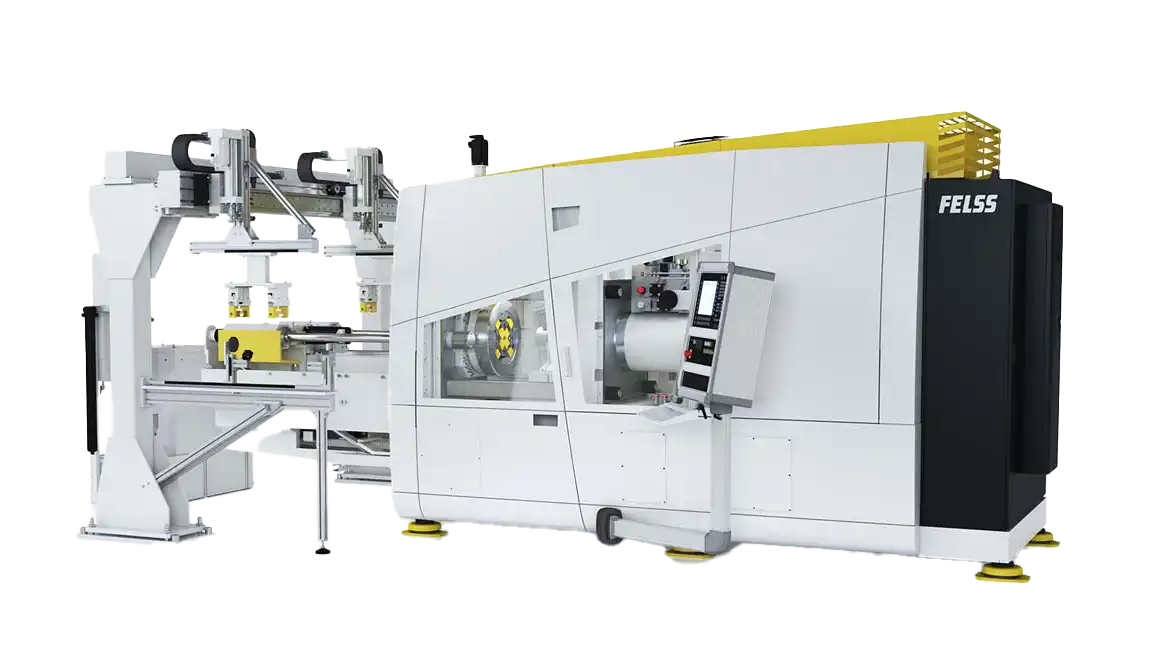ROUND CHAIN
Economical production of lightweight components through rotary swaging
The cold forming process Rotary swaging enables efficient and economical production of lightweight components. Several tool segments act simultaneously on a workpiece in rapid succession. The processed material begins to flow and is then Highly precise reshaped. The process is suitable for forming a wide variety of external and internal geometries. The technology characterizes the maximum design freedom for visible and non-visible components.
The Felss Group: experts in rotary swaging
As an expert in cold forming using Rotary swaging and Axial forming The Felss Group offers you the right machine to produce even the most precise workpieces using rotary swaging. Alternatively, we can provide you with Contract service providers can draw on all our experience and our modern machinery and take over the Component production on your behalf.

How does rotary swaging work?
The basic principle of rotary swaging is as fascinating as it is effective: several die segments repeatedly hit the workpiece in quick succession. The material begins to flow and is formed with high precision. At the same time, the workpiece is Cold forming further solidified. The tools hit the workpiece at a speed of more than 1,000 strokes per minute. Forming is carried out using anincremental process , whereby the stroke performed in each case is only 0.25 to 1.5 millimetres per base jaw. To be able to guarantee these critical requirements, rotary swaging machines achieve the precision of clockwork.

Applications of rotary swaging
Rotary swaging is characterized by a broad spectrum of Forms and different Forming degrees . It offers a much wider range of options than most others Cold forming process. For example, a hose connection is just as possible as the high-precision and fast production of steering spindles, drive shafts, airbag cylinders or adjusting wheel drives.
Advantages of the rotary swaging process
- Freely programmable units and speeds
- High design flexibility with reduced cycle times
- Minimal changeover times due to fewer change parts
- High reproducibility with maximum process reliability

Your added value with Felss
Felss stands for smart, customized solutions in cold forming. Our aim is to offer you real added value with our machines, components and services.
- Lightweight , weight-optimized use of materials thanks to intelligent material distribution.
- More resilient Improved component performance through targeted control of material properties.
- Resource-efficient waste avoidance and full material utilization through cold forming.
- Faster Shorter production times and optimized workflows thanks to innovative processes.
- More precise Highest accuracy of complex geometries thanks to Felss technologies.
- Tailor-made Optimal solutions, tailored to your individual requirements.

Generation e4.0
Energy-saving rotary kneading.

Rotary swaging machines HA
Reshape and return at the same time.

Rotary swaging machines FR
Simplest operation.
Produce the most complex geometries using rotary swaging
Due to the extremely low stroke heights of just 0.25 to 1.5 mm, rotary swaging is ideal for producing complex external geometries. The high degree of forming that can be achieved with this process also guarantees an impressive Freedom of design and enables the manufacture of a wide variety of products. The use of additional mandrels inside the pipe allows the At the same time, the internal geometry of the same complexity can be generated.
Lightweight construction thanks to rotary swaging
When forming by means of rotary swaging, the Fatigue strength of the workpiece increased by up to 30 %. This improves the load-bearing capacity and allows the production of hollow shafts and thus a lighter construction than with other manufacturing processes. The Weight saving is up to 50 %. In the automotive sector, this weight saving in shafts and other cold-formed parts is reflected in lower fuel consumption and, in the case of electric vehicles, a longer range.
What methods are there for rotary swaging?
In rotary swaging, a basic distinction is made between two process variants: feed kneading and piercing kneading. With both methods Tubes are machined as semi-finished products whose internal geometry can be produced simultaneously with the highest precision using internal tools (mandrels). Machining of the finished products is generally unnecessary.
Feed kneading
At the Feed kneading the workpiece is kneaded in axial direction through the machine, with the actual forming taking place at the inlet cone; the rear part of the tool cylinder is primarily used to calibrate the cross-section. In this process, the Length of the workpiece is not important and the area to be machined can also be freely selected. Transition angle limited during feed swaging.
Grooving
At the Plunge swaging the machine tool first carries out a radial movement. This is converted into a movement in the axial direction by means of an intermediate wedge. This not only allows significantly larger transition angles to be generated, but also the realization of Local reduction of the cross-section in selected areas of the workpiece is possible.

Come to us as early as the development phase of your projects
We support you throughout the entire process – from the drawing to the finished component and beyond.